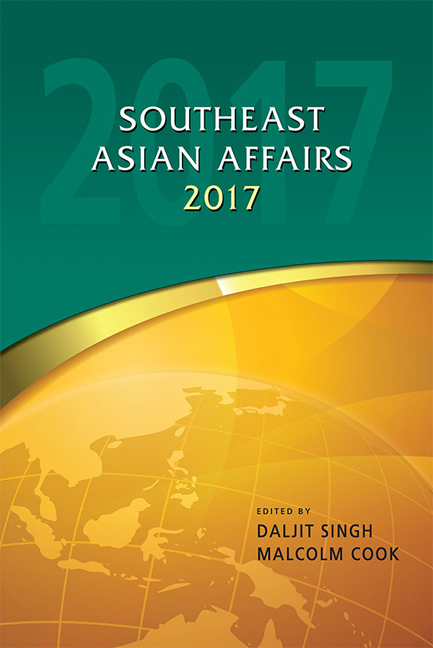Book contents
- Frontmatter
- Contents
- Foreword
- Introduction
- Acknowledgements
- THE REGION
- Southeast Asia in an Age of Strategic Uncertainty: Legal Rulings, Domestic Impulses, and the Ongoing Pursuit of Autonomy
- Southeast Asian Economies: In Search of Sustaining Growth
- Forging the ASEAN Economic Community, 2015 to 2016 — and Beyond
- Southeast Asia's Demographic Situation, Regional Variations, and National Challenges
- U.S.–Japan–Australia Strategic Cooperation in the Trump Era: Moving from Aspiration to Action
- Blurring the Distinction between Huaqiao and Huaren: China's Changing Policy towards the Chinese Overseas
- BRUNEI DARRUSALAM
- CAMBODIA
- INDONESIA
- LAOS
- MALAYSIA
- MYANMAR
- THE PHILIPPINES
- SINGAPORE
- THAILAND
- TIMOR-LESTE
- VIETNAM
Southeast Asian Economies: In Search of Sustaining Growth
from THE REGION
Published online by Cambridge University Press: 12 January 2018
- Frontmatter
- Contents
- Foreword
- Introduction
- Acknowledgements
- THE REGION
- Southeast Asia in an Age of Strategic Uncertainty: Legal Rulings, Domestic Impulses, and the Ongoing Pursuit of Autonomy
- Southeast Asian Economies: In Search of Sustaining Growth
- Forging the ASEAN Economic Community, 2015 to 2016 — and Beyond
- Southeast Asia's Demographic Situation, Regional Variations, and National Challenges
- U.S.–Japan–Australia Strategic Cooperation in the Trump Era: Moving from Aspiration to Action
- Blurring the Distinction between Huaqiao and Huaren: China's Changing Policy towards the Chinese Overseas
- BRUNEI DARRUSALAM
- CAMBODIA
- INDONESIA
- LAOS
- MALAYSIA
- MYANMAR
- THE PHILIPPINES
- SINGAPORE
- THAILAND
- TIMOR-LESTE
- VIETNAM
Summary
The year 2016 will be remembered for its extraordinary events. It started on a promising note with the signing of the Trans Pacific Partnership (TPP) Agreement in February 2016, after prolonged years of negotiations. This was followed by the unexpected United Kingdom vote in favour of leaving the European Union (Brexit) in June and Donald Trump's stunning victory in the U.S. presidential election in November. The latter event has now cast doubt over whether the TPP will be ratified. In Southeast Asia the death of Thailand's revered King Bhumibol Adulyadej, the world's longest-reigning monarch, in October, also marked another historical moment. China's launching of the Asian Infrastructure Investment Bank (AIIB) in January 2016 signalled a new era in global finance, as the new international bank is perceived to rival the U.S.-led World Bank. All ten economies in Southeast Asia have signed on to be members, although the ratification of Malaysia and the Philippines had not been completed at the time of writing.
Within the region there have been several changes that may affect its internal cohesiveness, as well as the region's economic and political relations with external powers. These include changes in political leadership in Laos, the Philippines, and Vietnam, while rising tensions over territorial disputes in the South China Sea have strained relations between China and some countries in the region. The signing of the TPP has also been perceived by some members of ASEAN as disruptive to ASEAN integration.
Amidst such changes, how did the Southeast Asian economies fare in 2016? The main objective of this chapter is to examine the growth of the ten Southeast Asian economies over the year and the main factors that have contributed to this growth. It also discusses the issues that have the potential to affect economic growth of these countries in 2017 and beyond.
Economic Performance in 2016
Overall Growth Performance
Global growth is projected to fall from 2015 to 2016 due to the uncertainties associated with Brexit and the global impact of the U.S. election results of November 2016. Even in the Asia Pacific, the growth rate for the region is forecast to stagnate from 2015 to 2016. Five of the Southeast Asian economies are expected to have slower growth in 2016 compared to 2015 (Table 1).
- Type
- Chapter
- Information
- Southeast Asian Affairs 2017 , pp. 19 - 42Publisher: ISEAS–Yusof Ishak InstitutePrint publication year: 2017



